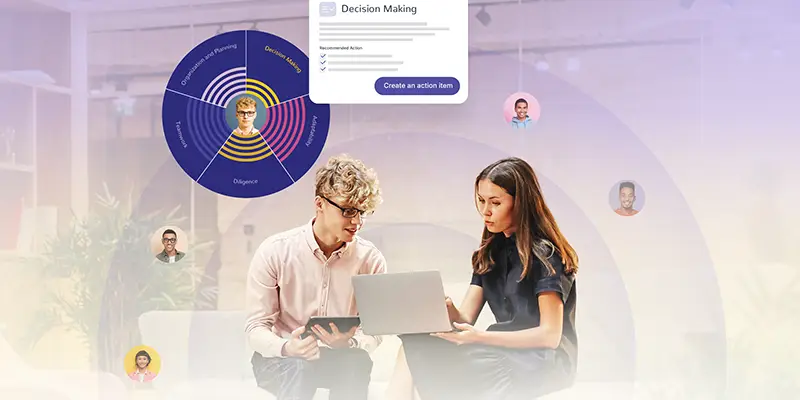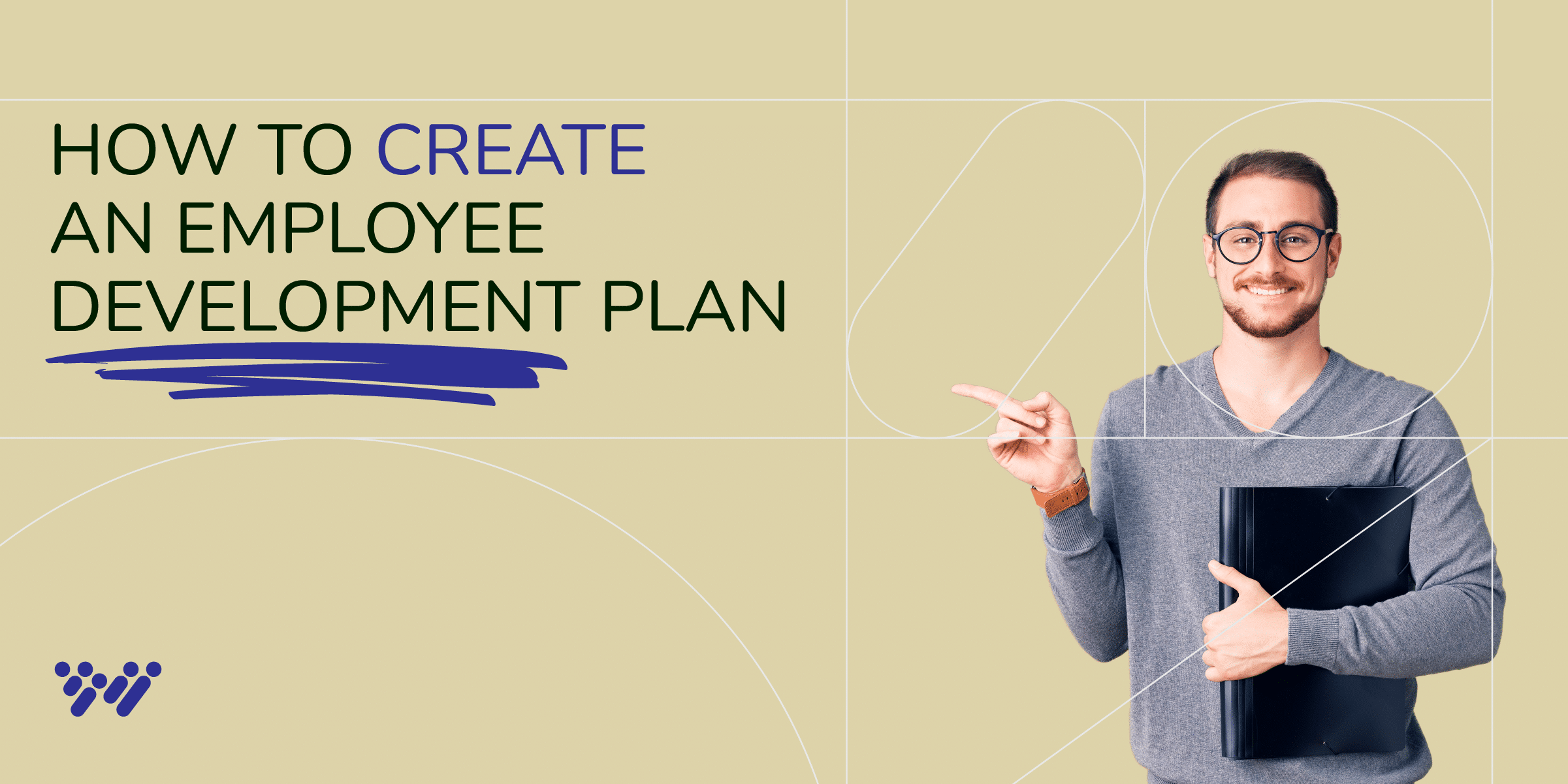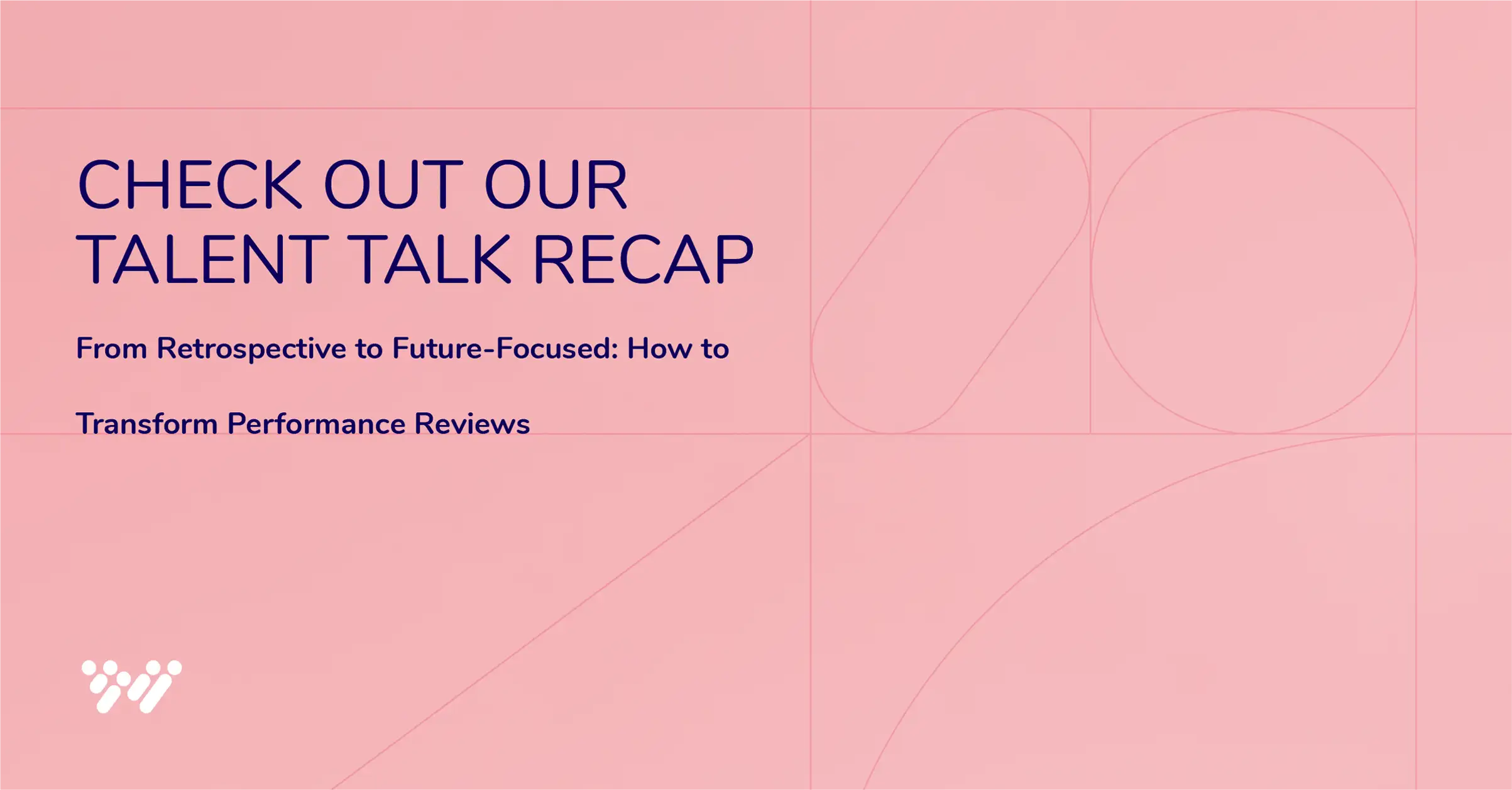There’s a (not-so-secret) secret to organizational success. It’s not a flashy product or a cutting-edge strategy. It’s something more fundamental yet often overlooked: the ongoing growth and development of your most significant asset — people. You may be familiar with performance management, semi-annual reviews, or learning & development strategies. These are all important factors for professional development, but often, they’re too infrequent to make a lasting impact. The most critical factor for improving employee performance is investing in and developing your talent over time. That’s where employee development comes in.
Employee development is the deliberate and persistent effort to enhance your employee’s skills, knowledge, and performance in a way that complements your organization and each individual’s goals and unique strengths.
From attracting top-tier talent to creating high performers to closing skills gaps and fostering retention, this blog uncovers the advantages of employee development with specific examples and strategies to get started.
Performance Management Versus Employee Development
What ways can Employee Development help you? (click to advance to the section below)
You may be wondering how employee development differs from performance management. Traditionally, performance management is focused on past achievements, looking backward to evaluate an employee’s contributions. In addition, performance management is, realistically, too much work for most managers to oversee — as managers don’t have the bandwidth to effectively plan, implement, and monitor ad-hoc training regiments for every employee in addition to their day-to-day responsibilities.
Employee development, on the other hand, is future-focused. Intertwined with performance goals, employee development starts with a focus on the input (future behavior) rather than the output (last year’s performance). These programs pinpoint an employee’s capabilities, behaviors, and interests to reveal where they have the most room for growth specific to their role. Then, professional development plans detail which steps to take to achieve that growth.
In addition, some of the most effective employee development programs are scalable and self-led, giving employees ownership over their careers. As partners in their employees’ growth, managers can then cheer their employees on as they develop. This teamwork makes growth and career advancement exciting, personal, and, most importantly, achievable.
Benefits of Investing In Employee Development
Many organizations have embraced modern hiring tools like psychometric tests and multi-measure assessments to evaluate candidate compatibility. These data-backed insights help ensure candidate fit and serve as a blueprint for ongoing development, but employee development plans are where true professional development plays out. Beyond the individual benefits employees reap, investing in development initiatives yields a multitude of advantages for your organization.
Attract Top Talent
In a tight labor market, your brand is everything. Skills training ranks among the top preferences for younger job seekers. (It’s worth noting that Gen Z is projected to make up about 30% of the workforce by 2030, so appealing to younger employees is more essential than ever.)
High performers aren’t just a bit more productive — they’re a whopping 400% more effective than their counterparts. As job complexity escalates, this productivity gap widens further. In management and software development roles, high performers showcase an astonishing 800% surge in productivity.
In addition, 66 percent of all workers consider employee skill development as the third-most important perk when evaluating potential job opportunities — trailing only health insurance and disability benefits. Given the competitive nature of talent acquisition, simply offering a job or a higher salary isn’t enough. Employees want a career.
Organizations truly committed to nurturing their employees’ growth can attract ambitious, high-performing individuals. To stand out and attract the best talent, your dedication to employee development should be evident in your job descriptions, career site, and every step of the recruitment process.
Retain High Performers
Organizations that fail to offer career development and upskilling avenues could be in for a rough ride. When employees exit, the consequences thin the company’s bottom line. The cost of replacing a single employee can range from half to twice their annual salary — and that’s a conservative estimate.
When it comes to maintaining a dream team, professional development plays a pivotal role. Similar to accepting a new job, 61% of employees percent see learning new skills as a major reason to stick with their job. Other research goes on to show that companies committed to development exhibit lower attrition rates.
With more than a quarter of workers reporting they plan to leave their jobs in the near future, ongoing employee development can be the difference between a robust or overworked and thinning workforce.

Increase Profitability
A soft skills development study from MIT Sloan showcased a 250% return on investment from soft skills training within a year, with a surge in worker productivity being the main driver of this gain. Other factors also came into play, including the ability to tackle intricate tasks with newfound speed, immediate enhancements in attendance, and a surge in training-driven retention. According to the Association of Talent Development (ATD), employers who invest in employee development have a 218% higher income per employee than those who don’t.
Effective employee development programs are more than just tools for enhancing productivity — they are catalysts for creating high performers, individuals who not only meet but exceed expectations, catapulting organizational growth and improving profitability.
See how our multi-measure assessment can save you time and money with our ROI calculator.
Foster Company Culture
Fostering company culture is essential for encouraging employees to make behavioral changes and positively attach themselves to the organization, but company cultures aren’t born out of thin air. They’re purposeful creations, connecting people, values, and the organization. It sets the tone for collaborative dynamics and respectful interactions, nurturing a shared sense of belonging in the workplace.
Organizations are responsible for crafting a culture of engagement deeply intertwined with ongoing employee growth, skill building, and continuous learning. Empowered by employee development programs that align with their core values, every member of the organization becomes a stakeholder in fostering a sense of belonging with the company.
Company cultures aren’t just nice to have. They’re a shared vision — a rallying cry — that gives employees a purpose. A strong company culture can minimize turnover while encouraging employees to continually grow and perform.
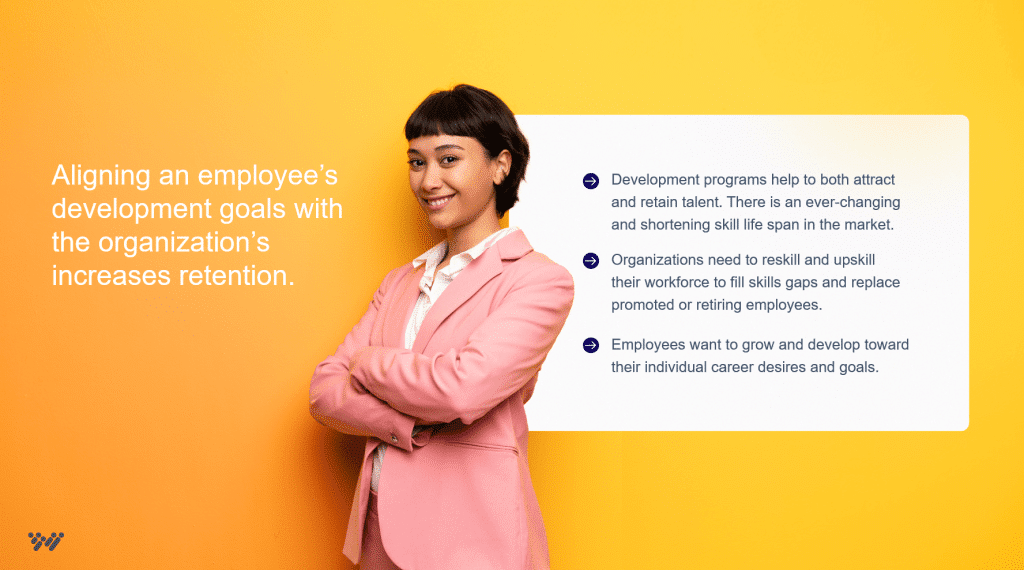
Close Skills Gaps
More than 82% of companies are gearing up for a transformative era of on-the-job learning and training. This is a response to the anticipation that automation and technological advancements will reshape around 85 million jobs while ushering in 97 million new opportunities by 2025.
Employee skill development plans are pivotal solutions for filling skills gaps and addressing organizational weaknesses. In addition to hiring external candidates, businesses can save time and resources by upskilling their existing workforce.
However, the evolving job market presents another unique challenge: identifying and developing talent for roles that haven’t been defined yet. Hiring and developing individuals based on their ability to grow and adapt is more essential than ever today.
Employee assessments play a vital role in evaluating these robust competencies, such as adaptability, problem-solving, and abstract thinking — strong predictors of ongoing success. Staying ahead means not only addressing current skills gaps but also fostering a workforce prepared for tomorrow.
Unburdening HR Teams and Managers with Employee-led Development
HR has long faced challenges in implementing development programs, which require significant time investments from HR teams and managers. However, when employees are solely dependent on manager-driven development, it often falls short. Managers are stretched thin and may not possess the necessary capabilities to effectively develop their teams.
The responsibility to develop employees cannot solely rest on the shoulders of HR teams or managers. Instead, everyone has a role to play. At the heart of fostering a thriving workplace culture lies the concept of employee-led development journeys. This transformative approach places the reins of their careers in the hands of employees, empowering them to own their advancements.
Tasha Eurich, PhD, an organizational psychologist, conducted extensive research on this matter. Her findings consistently underscore the positive impacts of cultivating self-awareness across the organization, as highlighted in her publication in the Harvard Business Review.
“Self-awareness seems to have become the latest management buzzword — and for good reason. Research suggests that when we see ourselves clearly, we are more confident and more creative. We make sounder decisions, build stronger relationships, and communicate more effectively. We’re less likely to lie, cheat, and steal. We are better workers who get more promotions. And we’re more effective leaders with more satisfied employees and more profitable companies.”
Tasha Eurich, PhD, Harvard Business Review
By integrating self-awareness and employee-led capabilities into the fabric of an organization, employee development transforms into a shared responsibility — and mission. This involves HR collaborating with managers during regular business activities rather than solely relying on them to identify and implement development opportunities.
A self-driven journey really starts when employees focus on role-critical attributes and behaviors with an immediate impact on performance. The best employee development solutions are also scalable, built for everyone, so that all employees gain access to high-quality development initiatives, not just leaders.
What Are the 4 Stages of Employee Development?
A talent lifecycle with best-fit talent starts with multi-measure assessments that identify high-potential candidates. Employee development tools like Wonderlic Develop then become the compass, guiding individuals through four distinct stages that shape their professional development.
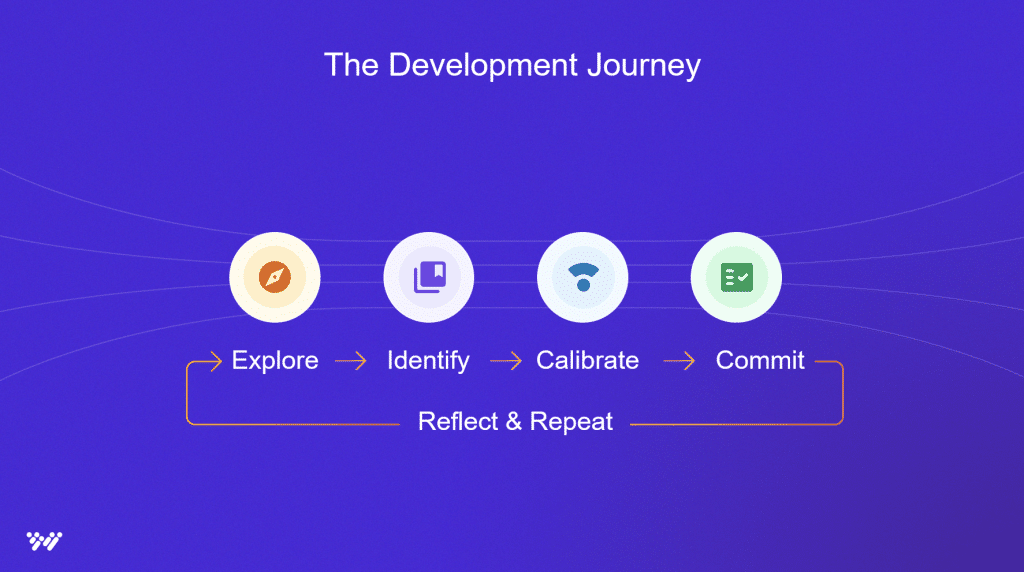
Stage 1: Explore
To start, an employee will explore the results from an employee development assessment like Wonderlic Develop to enhance their self-awareness. Employee assessments spotlight which behaviors, interests, and capabilities have the highest impact on role performance, including their natural strengths and potential gaps.
→ Example: Liam, a sales manager, begins his professional development journey by exploring his assessment results. Wonderlic Develop sheds light on the factors impacting his performance in the sales manager role, revealing natural strengths and potential areas for improvement. For instance, the assessment might highlight his exceptional communication skills as a strength while identifying the need for further development in leveraging data analytics for strategic decision-making.
Stage 2: Identify
Next, your employee development solution will identify the immediate behaviors most likely to make the biggest impact on performance and provide coaching tips, strategies, and goal-setting to help the employee make progress.
→ Example: Drawing from the results, Liam recognizes that enhancing proficiency in data-driven decision-making could really help his performance as a sales manager. The assessment results provide a clear roadmap, emphasizing the steps he can take to improve his decision-making.
Stage 3: Calibrate
Development is an ongoing process. It’s important for employees to pause and periodically reflect on their progress, by themselves, trusted collegues, or with managers. The time it takes can vary based on how often they practice, how far they are from their target, and the complexity of the behavior.
→ Example: Next, Liam engages in discussions with his manager to confirm his chosen high-impact behavior. Open communication ensures alignment and understanding among the team, validating that Liam’s focus on data-driven decision-making is well-supported. Collaborative calibration ensures the selected behavior is not only personally relevant but also recognized as valuable by key stakeholders.
Stage 4: Commit and Repeat
Finally, the employee will commit to working on something that they will be able to feel and see progress on in a couple of months. Over time, the employee will improve more high-impact skills. This process ensures ongoing development and incremental impact on employee performance.
→ Example: Ongoing, iterative development ensures Liam’s continuous growth and adaptability amidst evolving challenges in his role as a sales manager.
The Importance of Training and Development
Training and development (T&D) and learning and development (L&D) are terms often used interchangeably to refer to the teams and tactics of professional development. L&D teams function as a part of HR and play a pivotal role in sculpting a workforce that is both dynamic and resilient using principles from industrial-organizational psychology.
In some organizations, L&D teams may plan, implement, and facilitate employee development programs, whereas, in others, professional development plans may be driven by managers or self-led by employees. No matter the method of employee development you choose, there are several tools at your disposal.
Employee Development Methods
Professional development takes many forms, and there are countless employee development ideas. Some people thrive at industry conferences, while others shine with their peers and mentors. In reality, a fusion of methods often yields the most impactful results. Below, we’ll explore the tried-and-true methods of employee development.
Employee Development Assessments
Enter employee development assessments: the strategic evaluators of employee skills and competencies. These assessments excel at identifying strengths, revealing growth areas, and curating custom development roadmaps and learning content aligned with organizational goals.
Effective assessment techniques integrate feedback collection and psychometric tests. With clear targets, personalization, and actionable insights as compass points, employees and their managers can implement a plan to build power skills, propel career advancement, and contribute to the organization’s success.
Example: A project manager is struggling to effectively lead projects and collaborate with stakeholders. Using a psychometric assessment, they gain insights into their communication style and high-effort and low-effort power skills. They review their results and receive a customized development plan. They’re guided to the right training resources to reach their goals, and after a few months, they measure their progress and refine their goals and development program through reassessments.
Mentoring and Coaching
When rising talent is paired with skilled coaches and mentors, magic happens. These relationships offer custom guidance, ongoing support, and invaluable insights to boost power skills and hard skills. The distinction between a mentor and a coach is nuanced: mentors, often experienced leaders within the company, share practical wisdom and domain expertise. In contrast, coaches provide structured, results-driven support to enhance performance and cultivate skills.
How can HR design impactful employee development programs? They can orchestrate the pairing of employees with relevant mentors and coaches and prepare managers to embrace a coaching mindset — a trend Harvard Business Review recognizes as transformative. Effective mentoring and coaching programs also require comprehensive orientation, focused goal-setting, and feedback loops.
Example: A software engineer aspires to transition into a team lead role. She partners with a senior manager of software engineering to create a development plan outlining the skills she needs to develop, potential learning opportunities, and a timeline for achieving her goal. Through this experience, she gains valuable guidance, practical knowledge, and the confidence to apply for the management position.
Courses, Workshops, and Seminars
The golden ticket to connecting employees with expert insights? Courses, workshops, and seminars that immerse employees in interactive sessions and knowledge exchange within a structured learning environment.
But for these experiences to be exceptional, they need to be meticulously designed, engaging, and synced with employee development goals. Otherwise, they risk missing the mark and failing to address specific learning needs.
Example: A marketing team aims to steer toward more data-driven decisions. In this scenario, an employee proactively engages in their professional development by enrolling in a self-paced online course to help them use tools and measurements across content, social media, and data analytics.
Conferences and Industry Events
Organized events, seminars, workshops, and trade shows allow employees to learn, network, and gain insights from experts in their field. While they can be costly and require employees to take time off work, investing in them can be worth every penny. Think of conferences as the direct line to industry trends and hands-on learning. The immersive experience can also be incredibly motivational and engaging.
Making the most of these opportunities means weaving in post-conference insights into daily roles and projects. That’s how talent leaders and managers can ensure time and resources are put to the best use — and encourage employees to find real-world applications.
Example: The leaders of a company concerned with streamlining their supply chain processes are eager to learn about up-and-coming technologies. They send their operations team to a conference hosted by Gartner, a reputable source, to learn from and connect with leaders in the space. They return with fresh insights into supply chain digitization, innovative strategies, and best practices for implementing digital optimization solutions, plus new connections that could lead to future hires or vendor partnerships.
Leadership Development Programs
Managers play a pivotal role in team success. A Gallup survey reveals that 70% of team engagement hinges on managerial leadership. Yet, many managers lack the training to transition from individual contributors to effective people leaders.
The leap from individual contributor to manager requires a shift in behaviors and skills. Unfortunately, new leaders often receive minimal guidance. This leads to challenges for both managers navigating new roles and their direct reports who crave meaningful support.
Through leadership development programs, leaders can master team operations, goal setting, and motivation. HR is responsible for equipping employees with vital soft skills, blending training, workshops, mentoring, and assessments to shape well-rounded leaders.
Example: A new engineering manager who was promoted based on his individual contributions recognizes a gap in his leadership skills. This includes skills related to his ability to motivate a team, assign projects, and resolve conflict. He takes an employee development assessment and is given resources to improve his ability to lead and motivate his team.
Peer Learning Groups
Peer learning groups create a unique space where employees gather not just to learn but also to inspire each other through teamwork, creative problem-solving, and knowledge sharing. Simply put, collaboration sparks innovation and growth.
How can HR guide the journey? They can develop well-structured frameworks that define clear objectives and immediate applications to individuals’ roles or projects. They should also encourage employees to schedule regular meetings, set goals, and report their outcomes.
Example: An ambitious sales manager leverages employee development resources to create a peer learning group focused on negotiation tactics. Using the frameworks provided by HR, the group identifies their objectives, including improving negotiation strategies and learning from each other’s experiences. They also bring in sales leaders from the organization to share techniques for effective negotiation. Through collaborative problem-solving sessions, the group actively works through sales challenges together — and then reports their findings and best practices to the wider team.
External Certifications and Qualifications
External certifications and qualifications involve obtaining a reputable third-party credential outside of the workplace. They speak volumes about employees’ skills and subject mastery.
Certifications are also badges of trust and authority, validating both employee expertise and the company’s commitment to developing skilled professionals. The result is an elevated reputation among employees, customers, and candidates.
Example: An HR generalist seeks to deepen her knowledge of compensation structures and systems with the hopes of specializing her skills. She enrolls in a certification program hosted by SHRM, which includes comprehensive coursework, case studies, and practical assignments related to compensation and total rewards. With her earned certification, she begins supporting compensation projects and ultimately transitions into a more specialized role.
Putting a professional development plan together
Successful employee development hinges on embracing diverse learning experiences with a strong emphasis on employee-led growth. Picture a blend of work-related tasks, personal passions, and non-work experiences like volunteering or attending conferences. This diverse mix not only keeps employees informed about industry trends but also offers new perspectives and real-life experiences that add flavor to their professional journey.
In crafting the ideal learning environment, many businesses adopt the 70-20-10 learning model. This approach emphasizes that 70% of learning comes from experiential, on-the-job training, 20% from peer interactions, and 10% from formal training like seminars or courses. It rejects the one-size-fits-all notion, recognizing that growth, adaptation, and learning are continuous processes with multiple inputs required.
Once this foundation is laid, the next step involves identifying the right tools and services to amplify employee development. Scalable employee assessments play a key role, offering personalized development plans tailored to each employee’s role. These assessments integrate tangible insights into employees’ day-to-day work, transforming learning into an immersive experience. For companies already providing diverse learning opportunities, the key lies in strategically aligning them with individual and organizational objectives.
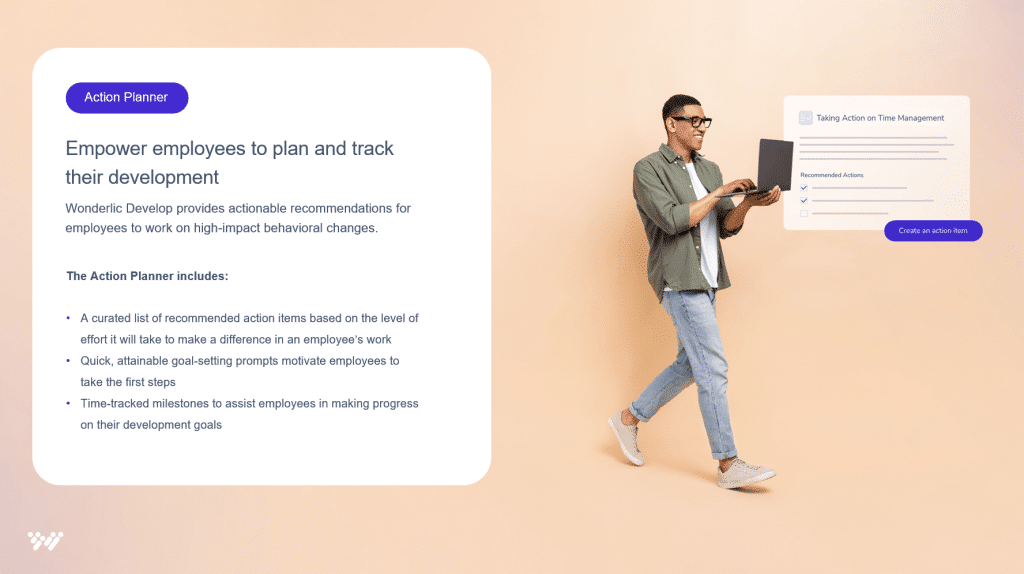
How Wonderlic Helps With Employee Development
Providing online courses, conferences, and educational programs is valuable, but there’s an additional layer of empowerment that comes from providing employees with data. Data about themselves, their strengths, and their potential.
Wonderlic Develop is a multi-measure assessment and employee development solution that measures cognitive ability, personality, and motivation to give employees comprehensive insights about their capabilities, behaviors, and interests, all in relation to their jobs.
Employees receive actionable coaching tips and strategies they can immediately implement into their day-to-day work for high-impact growth that improves workplace performance — without creating heavy overhead for the organization. This functionality is built into Wonderlic, saving you the time, expense, and headache of needing heavy services to deliver the results.
The best part? Develop isn’t reserved for senior leaders; it’s for everyone. Wonderlic Develop is like a personal guide for each employee to unlock their potential, boost their engagement, and help everyone crush their employee development goals.




